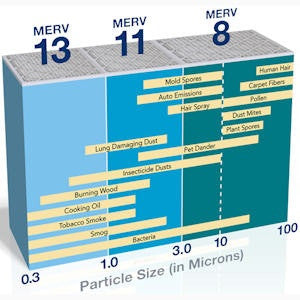
When it’s time to replace your furnace filter, making a decision isn’t as easy as just buying the first filter you see. There are some major differences between different types of furnace filters that can play a big role in how effective they are in filtering out dirt, dust and other pollutants from your HVAC system. When you spend money on a Honeywell furnace filter, you want to know that you are getting the right filter for your home. Confused about which type of filter to get? Let Your Filter Connection break down the three main types of furnace filters.
Pleated (disposable): The most common furnace filters are the types of filters that simply catch large particles and trap them in their mesh exterior. These filters can be made out of manmade or natural fibers. Because they trap dangerous particles such as dust or allergens, they are perfect for people with allergies who want major and instant relief through their air filtration system. They are the least expensive type of filter and only need to be replaced every few months. It’s important to use the recommended filter type for your HVAC system and pleated electrostatic are the most common. Further, these filters come in a variety of efficiency ratings which also should match what your HVAC system is designed to handle. We carry a huge selection of the most popular brands of furnace filter sizes and also can even create custom furnace filters.

Pleated HVAC Filter
Electrostatic: Electrostatic filters feature fine strands of polyester that have been electrically charged so they will attract and capture fine particulates in the air through static electricity. The primary disadvantage is that larger particles may not be picked up by electrostatic filters -- opposite to the dilemma of mechanical filters. These filters typically do not need to be replaced, although you will need to manually clean them every three months. The most common cleaning method is to simply remove the filter, spray it down with water, let it air-dry, and place it back into the furnace. Cleaning solutions such as detergent are only required when dealing with exceptional amounts of dirt and debris.

Electrostatic Filter
HEPA: Many people may not know a lot about filters but will know that HEPA are “the best”. These filters will often catch more than 99 percent of all potential pollutants. However, the vast majority of residential HVAC systems are not designed to use HEPA filters. The blower motor does not have enough force to push air through such dense filters and the air blockage may result in damage and expensive repairs. For this reason, more than likely you should avoid using HEPA furnace filters and consult your HVAC system manufacturer on the right choice. High cost HEPA filters are often used for commercial HVAC systems such as in hospitals or laboratories.

HEPA Filters
Electronic: Unlike the typical mechanical or electrostatic Filtrete filter, an electronic furnace filter doesn’t have fibers to capture particles. Instead, they are attracted to an electronic grid of wires that run throughout the filter. These types of filters are very efficient; in fact, they are so efficient that they need to be cleaned quite often to stay effective. In cleaning an electronic furnace filter, using a strong cleaning solution that will not degrade the filter’s metal component is highly recommended. Solely spraying down the filter with water may suffice, but a scrub-down or dishwasher is often necessary. Keep in mind electronic furnace filters are often expensive for their long-term efficiency, even considering their maintenance requirements.

Electronic Air Cleaner
Overall, a pleated disposable filter is the standard when it comes to keeping your home’s air clean and furnace running smoothly. They are convenient, affordable, and have proven to collect the dust and grime that can cause allergies and other health issues. Depending on your specific furnace, choose the correct filter size that’s right for you.
